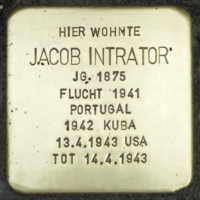Dr. Marion Kaplan’s Upcoming Book on Jewish Refugees


The Stolpersteine at Kurfürstendamm 185 in Berlin,
commemorating my paternal grandparents’ plights.
****
The Stolpersteine (stumbling stones) I got placed for my paternal grandparents outside their last Berlin residence note that in fleeing Hitler and the Nazis, my grandparents found temporary refuge in Portugal.
I therefore read, with poignant interest, Dr. Marion Kaplan’s fascinating paper “Lisbon is Sold Out! The Daily Lives of Jewish Refugees in Portugal during World War II”.
Dr. Kaplan was kind enough, recently, to communicate with me in-depth about this meaningful topic.
Question: Since writing your intriguing paper “Lisbon is Sold Out!”, have you come across any additional information regarding refugees fleeing Hitler via Lisbon?
Answer: Actually, since then, I have written a book about the experience of refugees as they fled toward Portugal and then lived lives in limbo until they could leave for safer havens across the Atlantic Ocean. Later in 2019, Yale will publish my JEWISH REFUGEES FLEEING HITLER: Hope and Anxiety in Portugal, 1940–1945. The book depicts the travails of refugees escaping Nazi Europe and awaiting their fate in Portugal. Drawing attention not only to the social and physical upheavals of refugee existence, I also highlight their feelings as they fled their homes and histories while begging strangers for kindness. I also examine their welcome in Portugal, where its dictator, António de Oliveira Salazar, admitted tens of thousands of Jews fleeing westward but set his secret police on those who did not move on quickly. Nevertheless, Portugal’s people left a lasting impression on refugees as caring and generous.
Life in limbo had at its core anxiety and fear, but also courage and resilience. Most refugees in Portugal showed strength and stamina as they faced unimagined challenges. For them, Lisbon emerged as a site of temporality and transition, a “no-man’s-land” between a painful past and a hopeful future. An emotional history of fleeing, the book probes how geography intersected with emotions, how specific locations touched refugees’ inner lives, including the borders they nervously crossed, the consulate lines they fretfully waited on, the smoky cafés they uneasily inhabited, or the overcrowded transatlantic ships that signaled their liberation. These sites induced feelings of frustration or relief – often both.
Taking my cue from the Pointillists who painted images with tiny dots, I use many individuals’ stories to create a large portrait of the daily lives and feelings of Jewish refugees caught between a lost past and an unpredictable future. And, paying careful attention to the emotions of refugees in Portugal may help us to understand Jewish heartbreak and perseverance in the 1940s but also to listen compassionately to refugees’ stories in our own times.
******
In previous blog posts, I interviewed Dr. Marion Kaplan about:
1) Women and the Holocaust;
2) European Jewish Memoirs; and
3) Advancing our Knowledge of the Holocaust
